 |
|
|
|
|
||||||||||||||||||||||||||
 |
||||||||||||||||||||||||||
|
The Forearm The forearm is the region of the ulna and radius. At the proximal (in proximity to the body) is the elbow. At the distal end (distant from the body) is the wrist. |
|
To come to terms with the forearm, we need to cement certain relationships and assign priorities. In that sense we can say that at the elbow, the forearm is dominantly the ulna. The ulna flexes and extends. At the wrist, the forearm is dominantly the radius. The radius is the structure which, at the wrist, supports the hand. The radius is the forearm bone of the hand. The ulna is the forearm bone of the elbow. The two bones are not just associated at the elbow and wrist joints, but cross attached by a flexible sheet - like the two posts of a canvas stretcher. The fibers are so organized so as to take the load when one pushes something heavy. U=================o elbow => ulna
Note that the radius spins on the axis of the radial head-capitellum at the elbow but orbits around the head of the ulna at the wrist. The motion stops when the radius bone abuts the ulna as the bones cross over. Well, usually it stops when the bones press together. Sometimes something goes crack or pop. Fractures of the forearm commonly follow a twist with a lot of momentum such as when the hand engages the ground as the body spins or topples around. The point of contact is a fulcrum for what follows. Depending on the compression or distraction or angularity of the forces, fractures through the two bones may be at different levels. The typical "angulation" seen in x-rays is an illusion of two dimensional projection. Typically the real angle is simply along the fold line drawn between the two fractures and is a rotational deformation around that oblique and seldom square with the x-ray axis. But chaos is chaos. Sometimes one bone - say the ulna - breaks and the other is levered out of its lesser joint. In that case the radius relationship to the capitellum gets pulled apart. That is, one bone is broken and the other dislocated at one end. Skin is quite elastic - to a point. The dense membranes which compartmentalize the forearm are not. Swelling or bleeding into the forearm compartments - especially the deep one - can overcome venous flow. Pressure in the veins begins to rise. When that pressure equals arterial pressure (blood pressure), flow stops. Pain is horrible. Any slight motion of the fingers is simply awful. That is an emergency. We don't worry about bones losing position - well, OK, a little. We can always redo a setting of the bone or even undo bad healing and revise. But circulation damage is not forgiving. Squeezing and generating severe pain in the name of bone position is like driving nails through your hat into your head to keep the wind from blowing your hat away. It had better be SOME hat!
|
|
|
||||||||||||||||||||